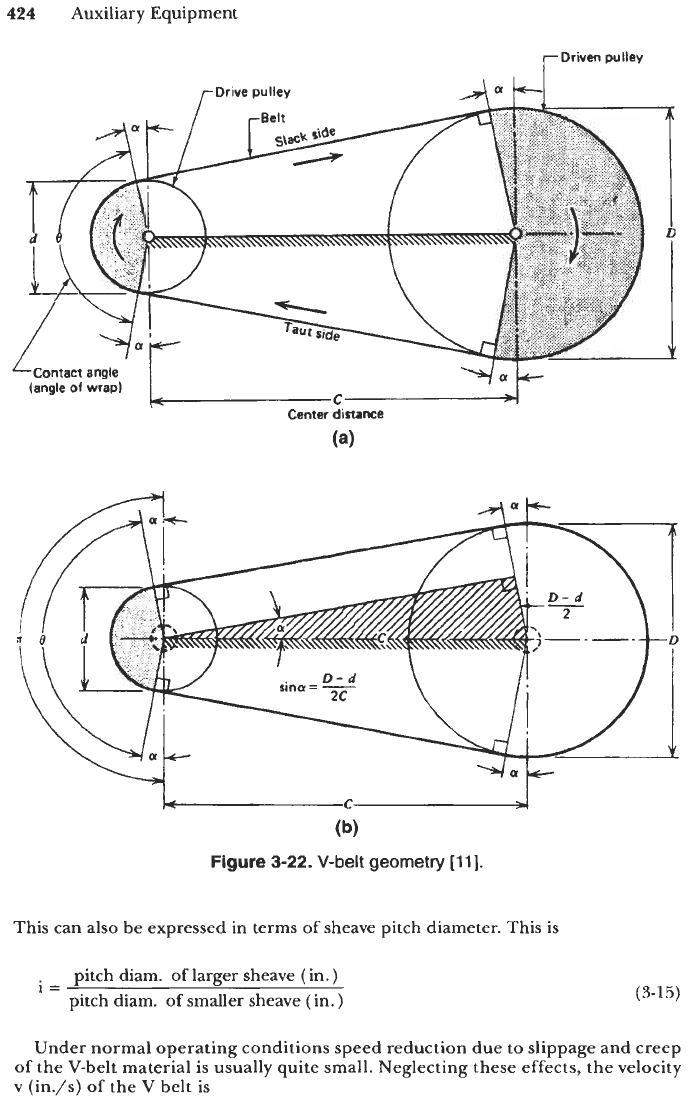Lyons W.C. (ed.). Standard handbook of petroleum and natural gas engineering.2001- Volume 1
Подождите немного. Документ загружается.

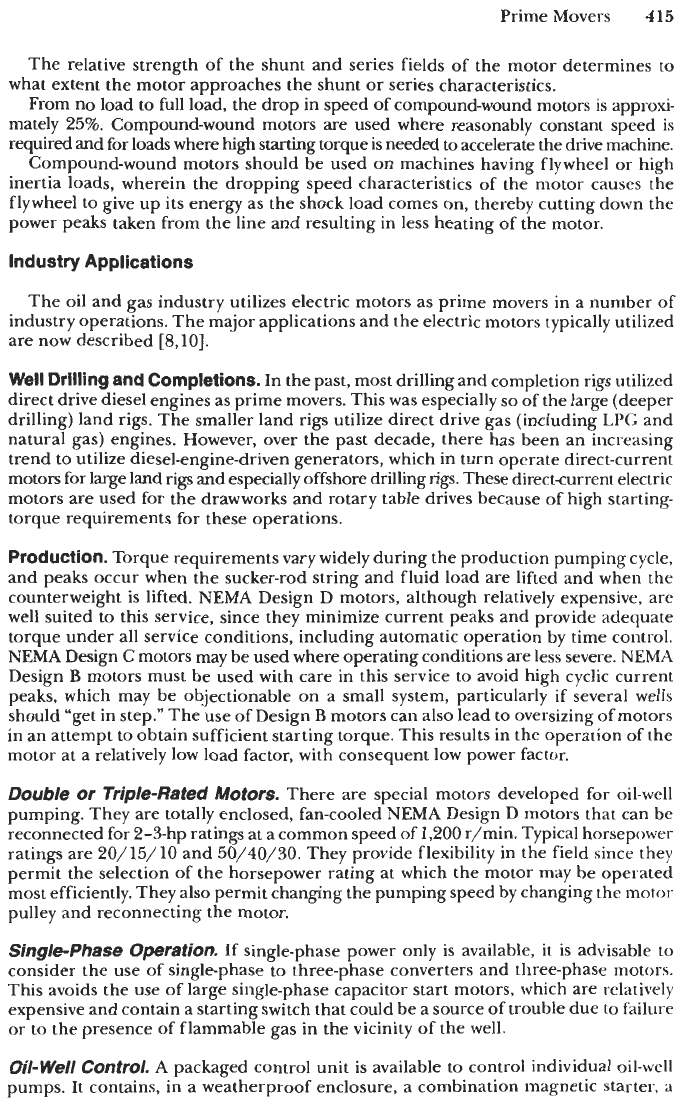
Prime Movers
415
The relative strength of the shunt and series fields of the motor determines to
what extent the motor approaches the shunt or series characteristics.
From no load to full load, the drop in speed
of
compound-wound motors
is
approxi-
mately 25%. Compound-wound motors are used where reasonably constant speed is
required and for loads where
high
starting torque is needed to accelerate the drive machine.
Compound-wound motors should be used on machines having flywheel or high
inertia loads, wherein the dropping speed characteristics of the motor causes the
flywheel to give up its energy as the shock load comes on, thereby cutting down the
power peaks taken from the line and resulting in less heating of the motor.
Industry Applications
The oil and gas industry utilizes electric motors as prime movers in a number of
industry operations. The major applications and the electric motors typically utilized
are now described [8,10].
Well
Drilling and Completions.
In the past, most drilling and completion rigs utilized
direct drive diesel engines as prime movers. This was especially
so
of the large (deeper
drilling) land rigs. The smaller land rigs utilize direct drive gas (including
LPG
and
natural gas) engines. However, over the past decade, there has been an increasing
trend to utilize diesel-enginedriven generators, which in turn operate direct-current
motors for large land rigs
and
especially offshore drilling rigs. These directcurrent electric
motors are used for the drawworks and rotary table drives because of high starting-
torque requirements for these operations.
Production.
Torque requirements vary widely during the production pumping cycle,
and peaks occur when the sucker-rod string and fluid load are lifted and when the
counterweight is lifted. NEMA Design D motors, although relatively expensive, are
well suited to this service, since they minimize current peaks and provide adequate
torque under all service conditions, including automatic operation by time control.
NEMA Design C motors
may
be used where
operating
conditions are less severe. NEMA
Design
B
motors must be used with care in this service to avoid high cyclic current
peaks, which may be objectionable on a small system, particularly
if
several wells
should “get in step.” The use of Design
B
motors can also lead to oversizing
of
motors
in an attempt to obtain sufficient starting torque. This results in the operation of the
motor at a relatively low load factor, with consequent low power factor.
Double
Or
Tripe-Rated
Motors.
There are special motors developed for oil-well
pumping. They are totally enclosed, fan-cooled NEMA Design D motors that can be
reconnected for 2-3-hp ratings at a common speed of 1,200 r/min. Typical horsepower
ratings are 20/15/10 and 50/40/30. They provide flexibility in the field since they
permit the selection of the horsepower rating at which the motor may be operated
most efficiently. They also permit changing the pumping speed by changing the motor
pulley and reconnecting the motor.
Singk-Phase
Operation.
If single-phase power only is available, it is advisable
to
consider the use of single-phase to three-phase converters and three-phase motors.
This avoids the use
of
large single-phase capacitor start motors, which are relatively
expensive and contain a starting switch that could be a source
of
trouble due to failure
or to the presence of flammable gas in the vicinity of the well.
Oil- Well
Control.
A
packaged control unit is available to control individual oil-well
pumps. It contains, in a weatherproof enclosure, a combination magnetic starter,
a
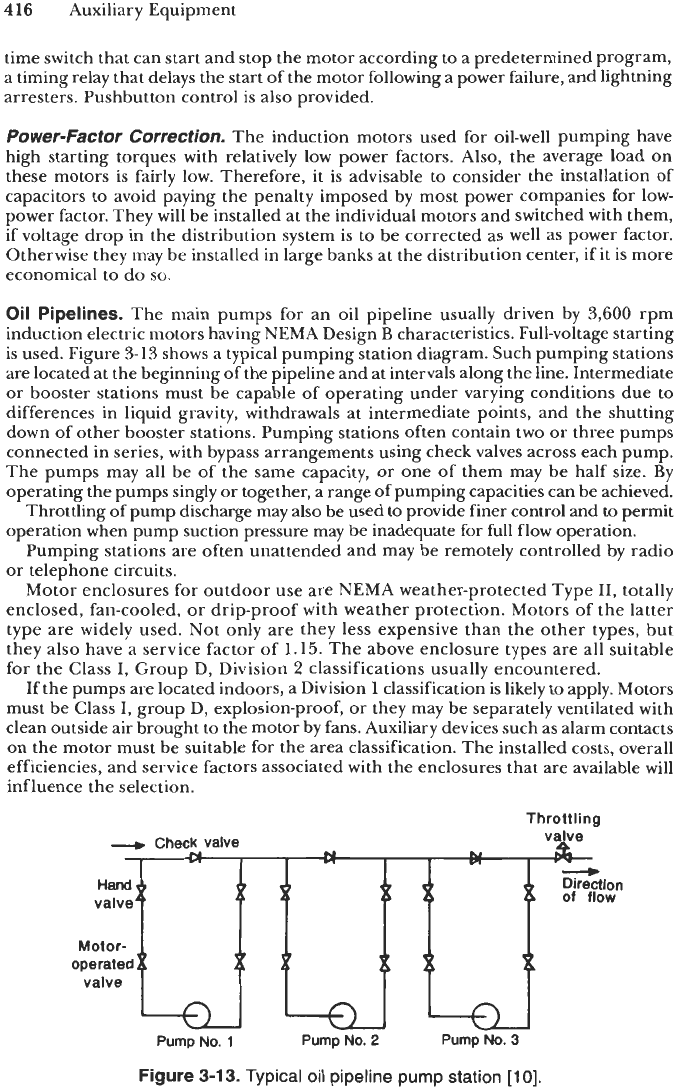
416
Auxiliary Equipment
time switch that can start and stop the motor according to a predetermined program,
a timing relay that delays the start
of
the motor following a power failure, and lightning
arresters. Pushbutton control is also provided.
Power-Factor Correction.
The induction motors used for oil-well pumping have
high starting torques with relatively low power factors. Also, the average load on
these motors is fairly low. Therefore, it is advisable to consider the installation of
capacitors
to
avoid paying the penalty imposed
by
most power companies for low-
power factor. They will be installed at the individual motors and switched with them,
if
voltage drop in the distribution system is to be corrected as well as power factor.
Otherwise they may be installed in large banks at the distribution center, if it is more
economical to
do
so.
Oil
Pipelines.
The main pumps for an oil pipeline usually driven by
3,600
rpm
induction electric motors having NEMA Design
B
characteristics. Full-voltage starting
is
used. Figure
3-13
shows
a
typical pumping station diagram. Such pumping stations
are located at the beginning of the pipeline and at intervals along the line. Intermediate
or
booster stations must be capable of operating under varying conditions due to
differences in liquid gravity, withdrawals at intermediate points, and the shutting
down of other booster stations. Pumping stations often contain two
or
three pumps
connected in series, with bypass arrangements using check valves across each pump.
The pumps may all be of the same capacity,
or
one of them may be half size. By
operating the pumps singly
or
together, a range of pumping capacities can be achieved.
Throttling of pump discharge may also be used to provide finer control
and
to
permit
operation when pump suction pressure may be inadequate for full flow operation.
Pumping stations are often unattended and may be remotely controlled by radio
or telephone circuits.
Motor enclosures for outdoor use are NEMA weather-protected Type
11,
totally
enclosed, fan-cooled, or drip-proof with weather protection. Motors of the latter
type are widely used. Not only are they less expensive than the other types, but
they also have
a
service factor of
1.15.
The above enclosure types are all suitable
for the Class
I,
Group D, Division
2
classifications usually encountered.
If
the pumps are located indoors, a Division
1
classification is likely to apply. Motors
must be Class
I,
group D, explosion-proof, or they may be separately ventilated with
clean outside air brought to the motor by fans. Auxiliary devices such as alarm contacts
on the motor must be suitable for the area classification. The installed costs, overall
efficiencies, and service factors associated with the enclosures that are available will
influence the selection.
Throttling
I1
8
II
Motor-
operated
valve
Pump
No.
1
PumpNo.
2
PumpNo.
3
Figure
3-13.
Typical
oil
pipeline pump
station
[lo].
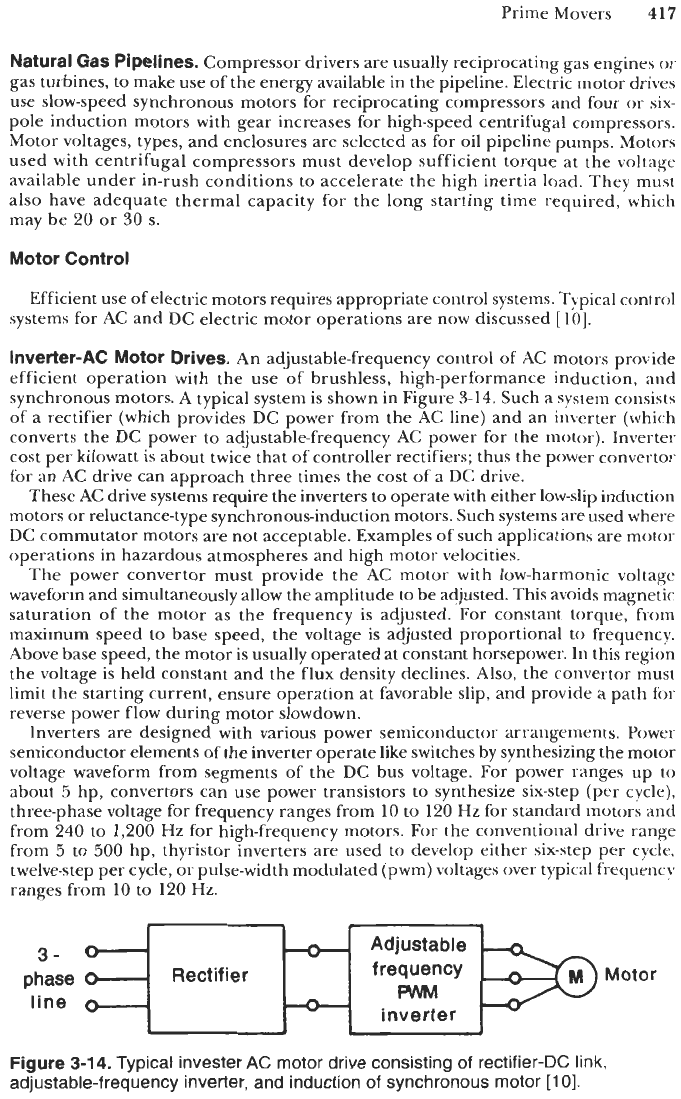
Prime Movers
417
Natural Gas Pipelines.
Compressor drivers are usually reciprocating gas engines or
gas
turbines, to make use of the energy available in the pipeline. Electric motor drives
use slow-speed synchronous motors for reciprocating compressors and four or six-
pole induction motors with gear increases for high-speed centrifugal compressors.
Motor voltages, types, and enclosures are selected as for oil pipeline pumps. Motors
used with centrifugal compressors must develop sufficient torque at the voltage
available under in-rush conditions to accelerate the high inertia load. They mu51
also have adequate thermal capacity for the long starting time required, which
may be
20
or
30
s.
Motor Control
Efficient use of electric motors requires appropriate control systems. Typical control
systems for
AC
and
DC
electric motor operations are now discussed
[IO].
Inverter-AC Motor Drives.
An adjustable-frequency control of
AC
motors provide
efficient operation with the use of brushless, high-performance induction, and
synchronous motors. A typical system is shown in Figure
3-14.
Such
a
system consists
of
a
rectifier (which provides
DC
power from the
AC
line) and an inverter (which
converts the
DC
power to adjustable-frequency AC power for the motor). Inverter
cost per kilowatt is about twice that
of
controller rectifiers; thus the power convertor
for an AC drive can approach three times the cost of
a
DC drive.
These AC drive systems require the inverters to operate with either low-slip induction
motors or reluctance-type synchronous-induction motors. Such systems are used where
DC commutator motors are not acceptable. Examples
of
such applications are motor
operations in hazardous atmospheres and high motor velocities.
The power convertor must provide the
AC
motor with low-harmonic voltage
waveform and simultaneously allow the amplitude
to
be adjusted. This avoids magnetic
saturation of the motor
as
the frequency is adjusted. For constant torque, from
maximum speed to base speed, the voltage is adjusted proportional
to
frequency.
Above base speed, the motor
is
usually operated at constant horsepower. In this region
the voltage is held constant and the flux density declines.
Also,
the convertor must
limit the starting current, ensure operation at favorable slip, and provide a path for
reverse power flow during motor slowdown.
Inverters are designed with various power semiconductor arrangements. Power
semiconductor elements of the inverter operate like switches by synthesizing the motor
voltage waveform from segments of the
DC
bus voltage. For power ranges up
to
about
5
hp, convertors can use power transistors to synthesize six-step (per cycle),
three-phase voltage for frequency ranges from
10
to
120
Hz for standard motors and
from
240
to
1,200
Hz for high-frequency motors. For the conventional drive range
from
5
to
500
hp,
thyristor inverters are used to develop either six-step per cycle,
twelve-step per cycle, or pulse-width modulated (pwm) voltages over typical frequency
ranges from
10
to
120
Hz.
Adjustable
phase
3
-
i=rt-F@
Rectifier frequency Motor
line
inverter
Figure
3-14.
Typical invester
AC
motor drive consisting
of
rectifier-DC link,
adjustable-frequency inverter, and induction
of
synchronous motor
[lo].
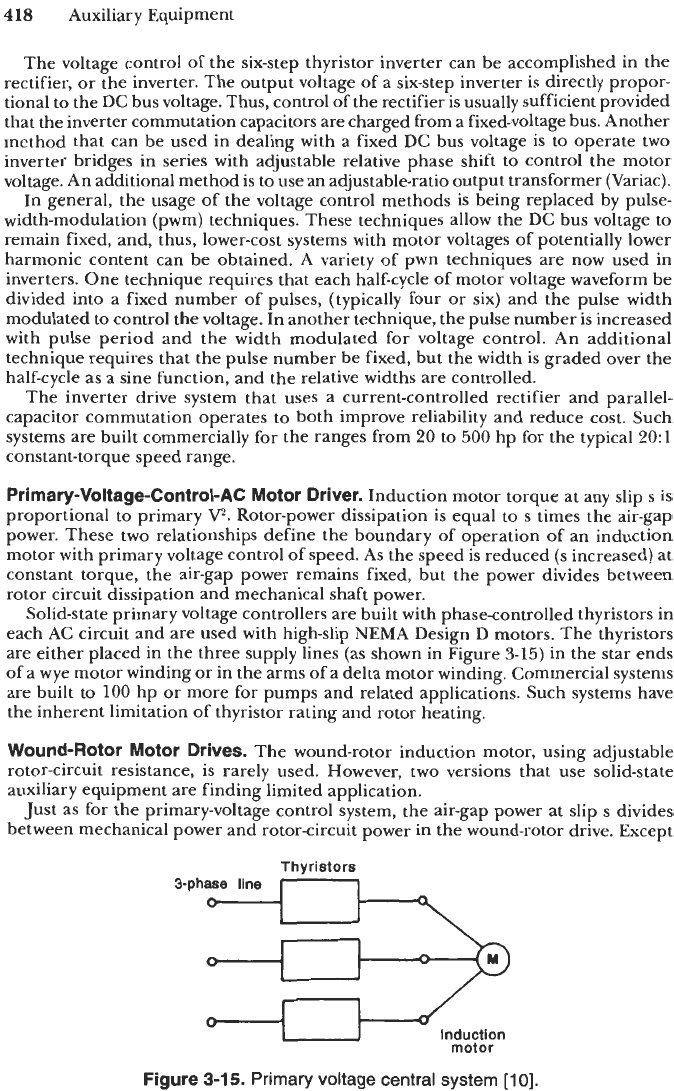
418
Auxiliary Equipment
The voltage control of the six-step thyristor inverter can be accomplished in the
rectifier, or the inverter. The output voltage of a six-step inverter is directly propor-
tional to the DC bus voltage. Thus, control of the rectifier is usually sufficient provided
that the inverter commutation capacitors are charged from a fixed-voltage bus. Another
method that can be used in dealing with a fixed DC bus voltage is to operate two
inverter bridges in series with adjustable relative phase shift to control the motor
voltage. An additional method is to use an adjustable-ratio output transformer (Variac).
In general, the usage of the voltage control methods is being replaced by pulse-
width-modulation (pwm) techniques. These techniques allow the DC bus voltage to
remain fixed, and, thus, lower-cost systems with motor voltages of potentially lower
harmonic content can be obtained.
A
variety of pwn techniques are now used in
inverters. One technique requires that each half-cycle
of
motor voltage waveform be
divided into a fixed number of pulses, (typically four or six) and the pulse width
modulated to control the voltage. In another technique, the pulse number is increased
with pulse period and the width modulated for voltage control. An additional
technique requires that the pulse number be fixed, but the width is graded over the
half-cycle as a sine function, and the relative widths are controlled.
The inverter drive system that uses a current-controlled rectifier and parallel-
capacitor commutation operates to both improve reliability and reduce cost. Such
systems are built commercially for the ranges from
20
to
500
hp for the typical
20:l
constant-torque speed range.
Primary-Voltage-Control-AC
Motor
Driver.
Induction motor torque at any slip
s
is
proportional to primary
V.
Rotor-power dissipation is equal to
s
times the air-gap
power. These two relationships define the boundary of operation of an induction
motor with primary voltage control
of
speed. As the speed is reduced
(s
increased) at
constant torque, the air-gap power remains fixed, but the power divides between
rotor circuit dissipation and mechanical shaft power.
Solid-state primary voltage controllers are built with phasecontrolled thyristors in
each AC circuit and are used with high-slip NEMA Design
D
motors. The thyristors
are either placed in the three supply lines (as shown in Figure
3-15)
in the star ends
of
a wye motor winding or in the arms of a delta motor winding. Commercial systems
are built to
100
hp or more for pumps and related applications. Such systems have
the inherent limitation of thyristor rating and rotor heating.
Wound-Rotor Motor
Drives.
The wound-rotor induction motor, using adjustable
rotor-circuit resistance, is rarely used. However, two versions that use solid-state
auxiliary equipment are finding limited application.
Just as for the primary-voltage control system, the air-gap power at slip s divides
between mechanical power and rotor-circuit power in the wound-rotor drive. Except
Thyristors
motor
Figure
3-15.
Primary
voltage
central system
[lo].
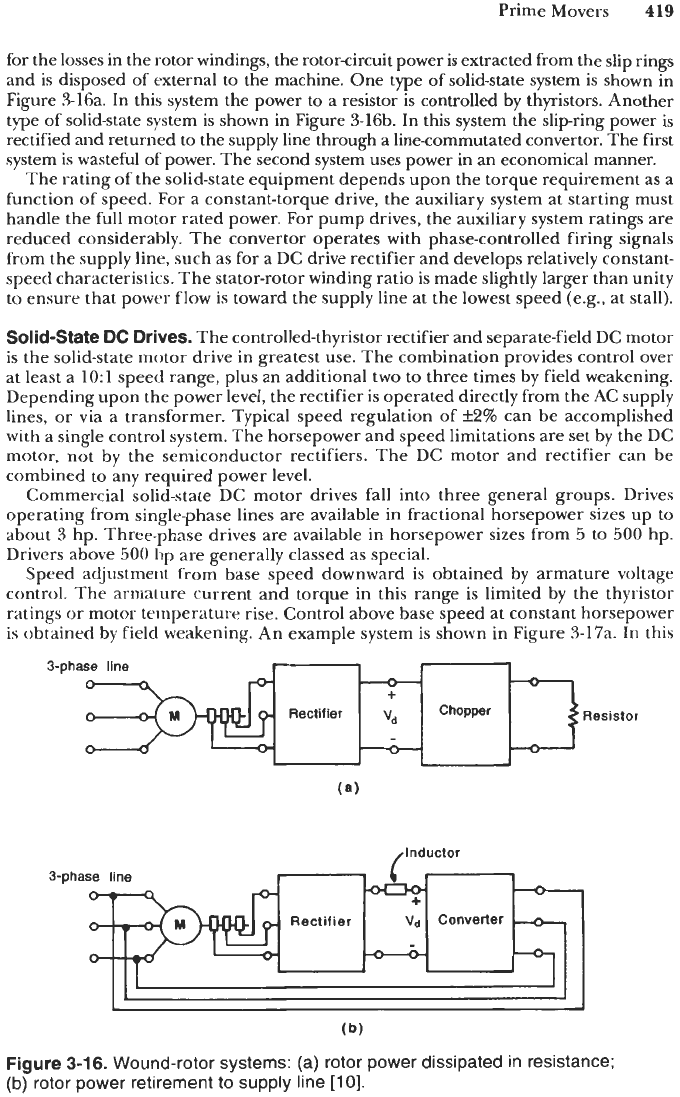
Prime Movers
419
3-phase line
r
--
1
+
Rectifier
V,,
v-
for the losses in the rotor windings, the rotor-circuit power is extracted from the slip rings
and is disposed of external to the machine. One type
of
solid-state system is shown in
Figure 3-16a. In this system the power to a resistor is controlled by thyristors. Another
type of solid-state system is shown in Figure 3-16b. In this system the slipring power
is
rectified and returned to the supply line through a line-commutated convertor. The first
system is wasteful of power. The second system uses power in an economical manner.
The rating of the solid-state equipment depends upon the torque requirement as a
function of speed. For a constant-torque drive, the auxiliary system at starting must
handle the full motor rated power. For pump drives, the auxiliary system ratings are
reduced considerably. The convertor operates with phase-controlled firing signals
from the supply line, such as for a
DC
drive rectifier and develops relatively constant-
speecl characteristics. The stator-rotor winding ratio is made slightly larger than unity
to
ensure that power flow is toward the supply line at the lowest speed (e.g., at stall).
Solid-state DC Drives.
The controlled-thyristor rectifier and separate-field DC motor
is the solid-state motor drive in greatest use. The combination provides control over
at least a
1O:l
speed range, plus an additional two to three times by field weakening.
Depending upon the power level, the rectifier is operated directly from the AC supply
lines, or via a transformer. Typical speed regulation of
*2%
can be accomplished
with a single control system. The horsepower and speed limitations
are
set by the DC
motor, not by the semiconductor rectifiers. The
DC
motor and rectifier can be
combined to any required power level.
Commercial solid-state
DC
motor drives fall into three general groups. Drives
operating from single-phase lines are available in fractional horsepower sizes
up
to
about
3
hp. Three-phase drives are available in horsepower sizes from
5
to
500
hp.
Drivers above
500
hp are generally classed
as
special.
Speed adjustment from base speed downward is obtained by armature voltage
control. The armature current and torque in this range is limited by the thyristor
ratings or motor temperature rise. Control above base speed at constant horsepower
is
obtained by field weakening. An example system is shown in Figure
3-17a.
In this
f
Cbwr
Resistor
/Inductor
3-phase line
-
L
"
+
vd
Converter
-
Rectifier
,..
-
(b)
Figure
3-1
6.
Wound-rotor systems: (a) rotor power dissipated in resistance;
(b)
rotor power retirement to supply line
[lo].
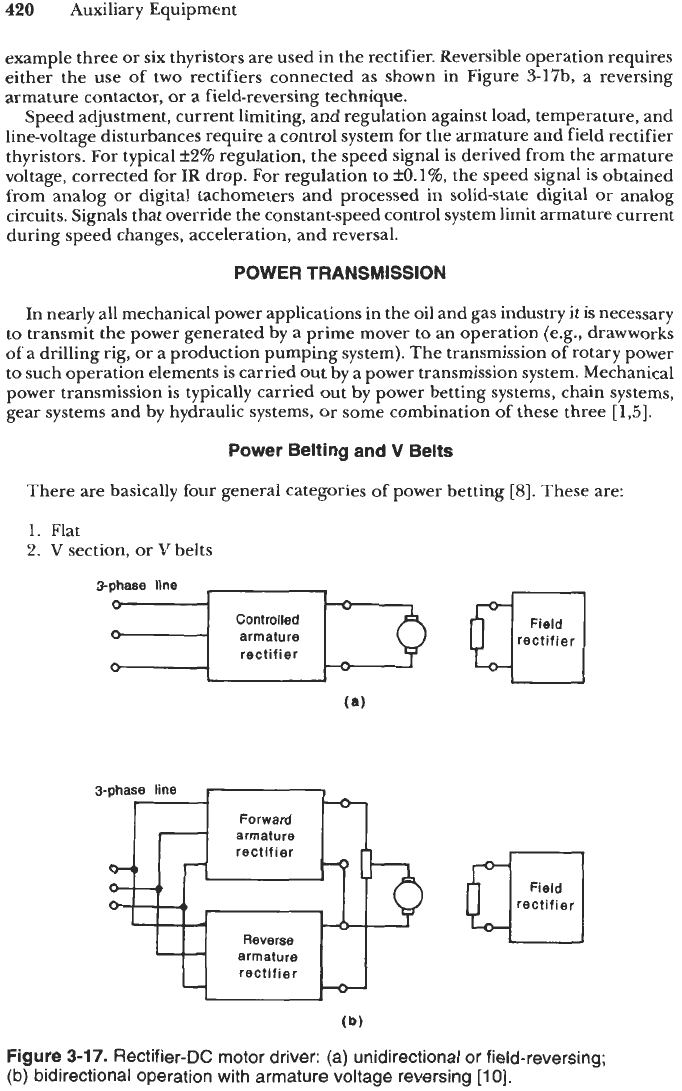
420
Auxiliary Equipment
example three or six thyristors are used in the rectifier. Reversible operation requires
either the use of two rectifiers connected as shown in Figure 3-17b, a reversing
armature contactor,
or
a
field-reversing technique.
Speed adjustment, current limiting, and regulation against load, temperature, and
line-voltage disturbances require a control system for the armature and field rectifier
thyristors. For typical
f2%
regulation, the speed signal is derived from the armature
voltage, corrected for
IR
drop. For regulation to
*0.1%,
the speed signal is obtained
from analog or digital tachometers and processed in solid-state digital or analog
circuits. Signals that override the constant-speed control system limit armature current
during speed changes, acceleration, and reversal.
POWER TRANSMISSION
In nearly all mechanical power applications in the oil and gas industry it is necessary
to transmit the power generated by a prime mover to an operation (e.g., drawworks
of a drilling rig,
or
a production pumping system). The transmission of rotary power
to such operation elements is carried out by a power transmission system. Mechanical
power transmission is typically carried
out
by power betting systems, chain systems,
gear systems and by hydraulic systems, or some combination of these three
[1,5].
Power Belting and
V
Belts
There are basically four general categories of power betting
[8].
These are:
1.
Flat
2.
V
section,
or
V
belts
Sphase line
ControlIed
rectifier
rectifier
Field
rectifier
a
(b)
Figure
3-17.
Rectifier-DC motor driver: (a) unidirectional or field-reversing;
(b) bidirectional operation with armature voltage reversing
[lo].
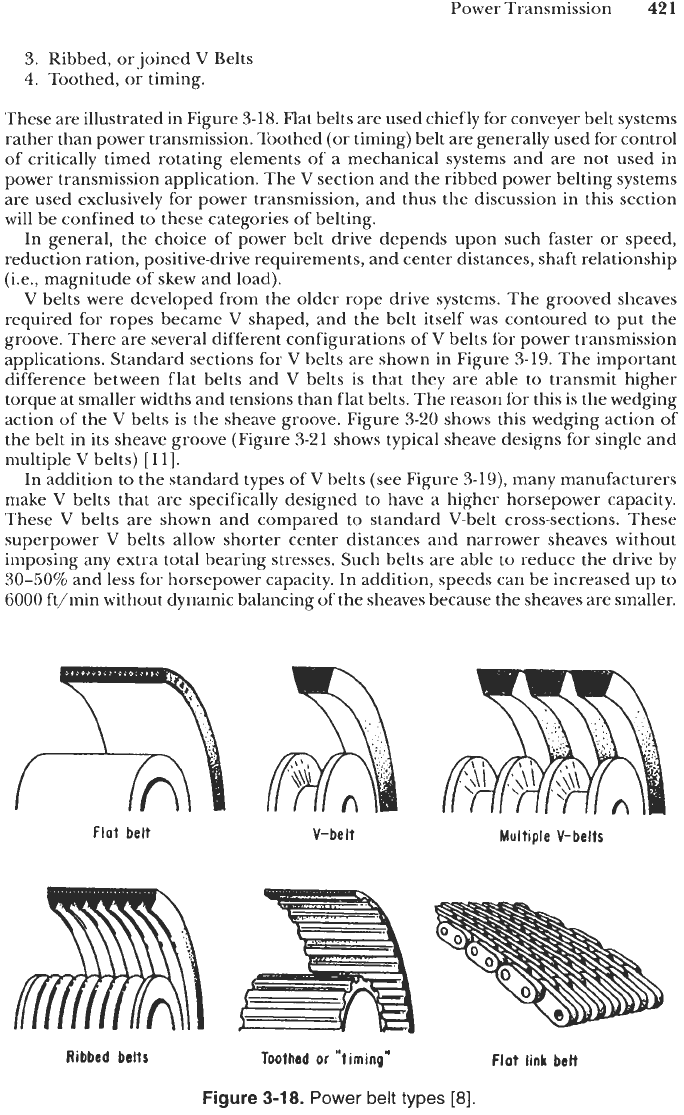
Power Transmission
421
3.
Ribbed, or joined
V
Belts
4.
Toothed, or timing.
These are illustrated in Figure
3-18.
Flat belts are used chiefly for conveyer belt systems
rather than power transmission. Toothed (or timing) belt are generally used for control
of critically timed rotating elements of a mechanical systems and are not used in
power transmission application. The
V
section and the ribbed power belting systems
are used exclusively for power transmission, and thus the discussion in this section
will be confined to these categories of belting.
In general, the choice of power belt drive depends upon such faster or speed,
reduction ration, positive-drive requirements, and center distances, shaft relationship
(i.e., magnitude of skew and load).
V
belts were developed from the older rope drive systems. The grooved sheaves
required for ropes became
V
shaped, and the belt itself was contoured to put the
groove. There are several different configurations
of
V
belts for power transmission
applications. Standard sections for
V
belts are shown in Figure
3-19.
The important
difference between flat belts and
V
belts is that they are able to transmit higher
torque at smaller widths and tensions than flat belts. The reason for this is the wedging
action of the
V
belts is the sheave groove. Figure
3-20
shows this wedging action
of
the belt in its sheave groove (Figure
3-21
shows typical sheave designs for single and
multiple
V
belts)
[
111.
In addition to the standard types of
V
belts (see Figure
3-19),
many manufacturers
make
V
belts that are specifically designed to have a higher horsepower capacity.
These
V
belts are shown and compared to standard V-belt cross-sections. These
superpower V belts allow shorter center distances and narrower sheaves without
imposing any extra total bearing stresses. Such belts are able to reduce the drive by
30-50%
and less for horsepower capacity. In addition, speeds can be increased up to
6000
ft/min without dynamic balancing of the sheaves because the sheaves are smaller.
Flot beit
V-bett Multiple V-belts
Toothed
or
“timing‘
Flot
link bett
Ribbed belts
Figure
3-18.
Power
belt
types
[8].
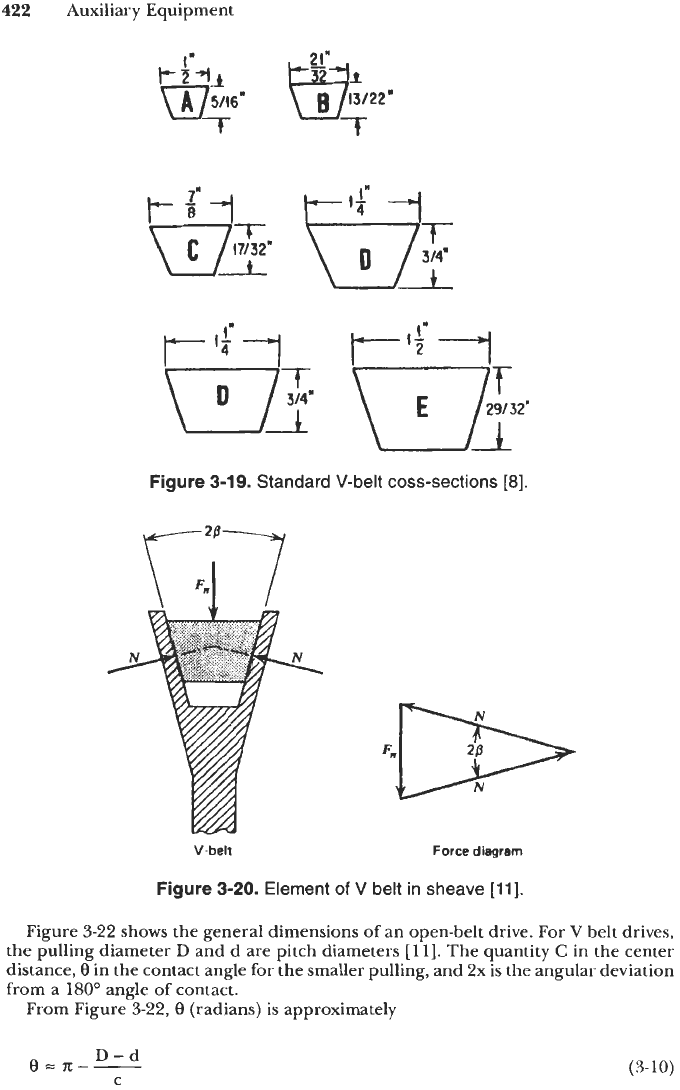
422
Auxiliary Equipment
Figure
3-19.
Standard
V-belt
coss-sections
[8].
V-belt
Force
diagram
Figure
3-20.
Element
of
V
belt
in sheave
[ll].
Figure 3-22 shows the general dimensions
of
an open-belt drive. For
V
belt drives,
the pulling diameter D and d are pitch diameters
[
111.
The quantity
C
in the center
distance,
8
in the contact angle for the smaller pulling, and
2x
is
the
angular deviation
from a
180”
angle
of
contact.
From Figure 3-22,
8
(radians) is approximately
D-d
o=x--
(3-10)
C
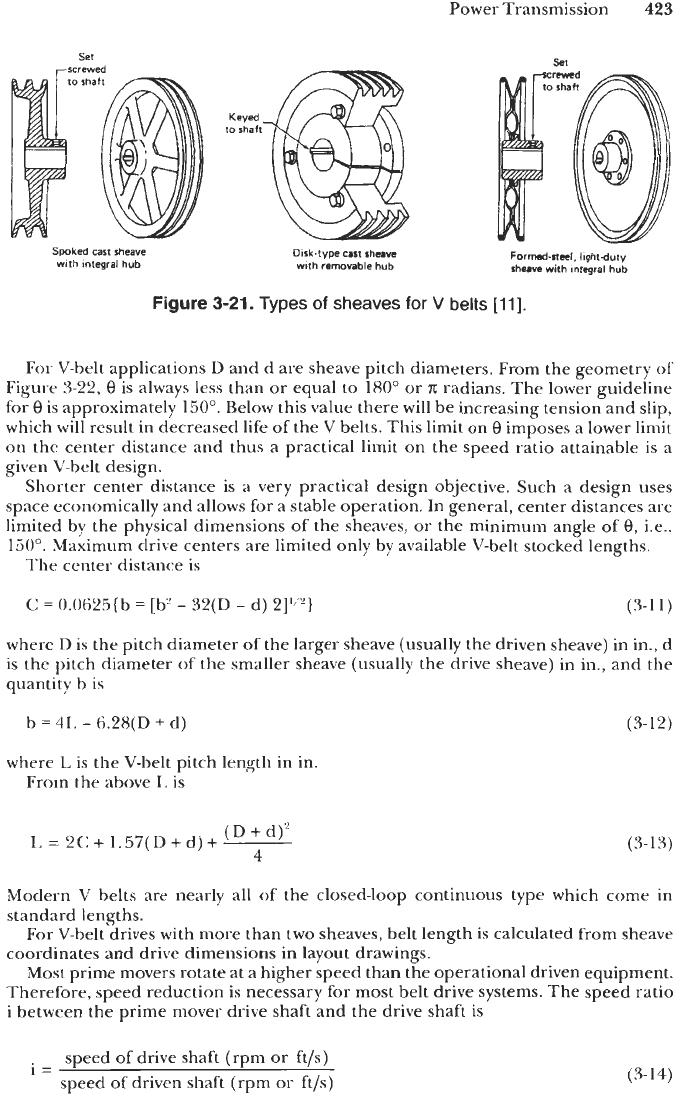
Power Transmission
423
Sel
Keyed
10
shah
Spoked
cast sheave
with
integral hub
Disk.tvpe
cast
sheave
wifh
removable
hub
Ford-steel.
light.duty
shave wifh integral hub
Figure
3-21.
Types
of
sheaves
for
V
belts
[If].
For
V-belt applications
D
and d are sheave pitch diameters. From the geometry
of
Figure
3-22,
8
is always less than or equal to
180"
or
x
radians. The lower guideline
for
8
is
approximat.ely
150".
Below this value there
will
be increasing tension and slip,
which
will
result in decreased life of the
V
belts. This limit on
8
imposes a lower limit
on the center distance and thus a practical limit on the speed ratio attainable is a
given V-belt design.
Shorter center distance is
a
very practical design objective. Such a design uses
space economically and allows
for
a
stable operation. In general, center distances art
limited by the physical dimensions of the sheaves, or the minimum angle of
8,
Le..
150". Maximum drive centers are limited only by available V-belt stocked lengths.
The
center distance
is
C
=
0.0@25{b
=
[h'
-
32(D
-
d)
Z]'")
(3-1
1)
where
D
is the pitch diameter of the larger sheave (usually the driven sheave) in in., d
is the pitch diameter of the smaller sheave (usually the drive sheave) in in., and the
quantity b
is
b
=
41.
-
6.28(D
+
d)
(3-12)
where
L
is
the V-belt pitch length in in.
From the above
I,
is
(3-1
3)
(D+d)2
4
1>
=
2C:
+
1.57(
D
+
d)
+
-
Modern
V
belts are nearly all of the closed-loop continuous type which come in
standard lengths.
For V-belt drives with more than two sheaves, belt length is calculated from sheave
coordinates and drive dimensions in layout drawings.
Most prime movers rotate at a higher speed than the operational driven equipment.
Therefore, speed reduction is necessary for most belt drive systems. The speed ratio
i
between the prime mover drive shaft and the drive shaft is
,
speed
of
drive shaft (rpm or
ft/s)
speed of driven shaft (rpm or ft/s)
s=
(3-14)
